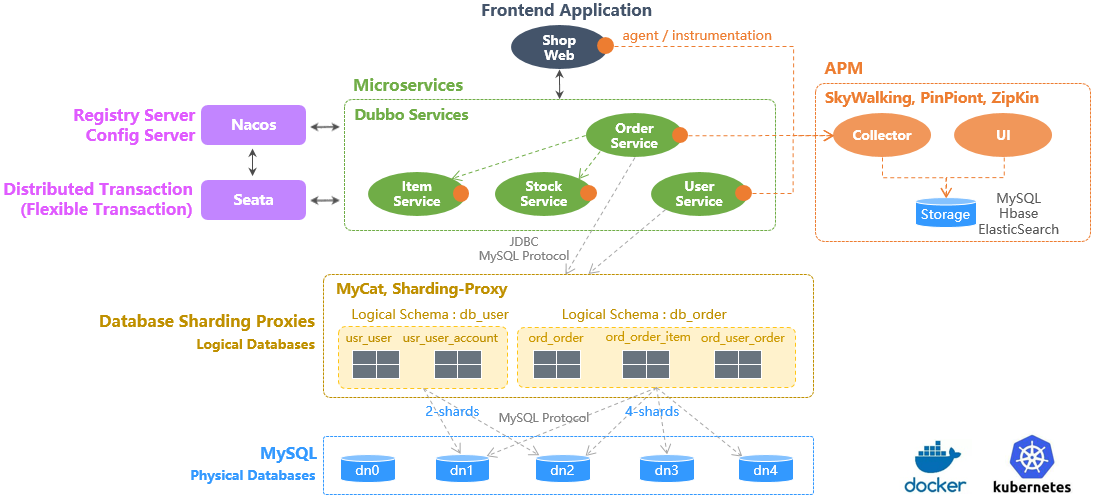 Import OpenTelemetry Data
Import OpenTelemetry Data
This document was translated by ChatGPT
#1. Data Flow
Sending via otel-collector to deepflow-agent:
Sending directly to deepflow-agent:
#2. Configure OpenTelemetry
We recommend using the agent mode of otel-collector to send trace data to deepflow-agent to avoid data transmission across K8s nodes. Of course, using the gateway mode of otel-collector is also completely feasible. The following document introduces the deployment and configuration methods using otel-agent as an example.
#2.1 Install otel-agent
Refer to the OpenTelemetry documentation (opens new window) for relevant background knowledge. If OpenTelemetry is not yet available in your environment, you can quickly deploy an otel-agent DaemonSet in the open-telemetry namespace using the following command:
kubectl apply -n open-telemetry -f https://raw.githubusercontent.com/deepflowio/deepflow-demo/main/open-telemetry/open-telemetry.yaml
After installation, you can see a list of components in the environment:
kubectl get all -n open-telemetry
| Type | Component |
|---|---|
| Daemonset | otel-agent |
| Service | otel-agent |
| ConfigMap | otel-agent |
If you need to use other versions or updated opentelemetry-collector-contrib, find the desired image version in the otel-docker (opens new window) repository, and then update the image using the following command:
LATEST_TAG="xxx" # FIXME
kubectl set image -n open-telemetry daemonset/otel-agent otel-agent=otel/opentelemetry-collector-contrib:${LATEST_TAG}
2
3
#2.2 Configure otel-agent
We need to configure otel-agent-config.exporters.otlphttp in the otel-agent ConfigMap to send traces to DeepFlow. First, query the current configuration:
kubectl get cm -n open-telemetry otel-agent-conf -o custom-columns=DATA:.data | \
grep -A 5 otlphttp:
2
deepflow-agent uses ClusterIP Service to receive traces, modify the otel-agent configuration as follows:
otlphttp:
traces_endpoint: 'http://deepflow-agent.deepflow/api/v1/otel/trace'
tls:
insecure: true
retry_on_failure:
enabled: true
2
3
4
5
6
Additionally, to ensure the IP on the Span sending side is passed to DeepFlow, add the following configuration:
processors:
k8sattributes:
resource:
attributes:
- key: app.host.ip
from_attribute: k8s.pod.ip
action: insert
2
3
4
5
6
7
Finally, in the service.pipeline, add the following to the traces section:
service:
pipelines:
traces:
processors: [k8sattributes, resource] # Ensure k8sattributes processor is processed first
exporters: [otlphttp]
2
3
4
5
#3. Configure DeepFlow
Next, we need to enable the data receiving service of deepflow-agent.
First, determine the collector group ID where deepflow-agent is located, usually the ID of the group named default:
deepflow-ctl agent-group list
Check if the collector group already has a configuration:
deepflow-ctl agent-group-config list
If there is already a configuration, export it to a yaml file for modification:
deepflow-ctl agent-group-config list <your-agent-group-id> -o yaml > your-agent-group-config.yaml
Modify the yaml file to ensure it contains the following configuration items:
vtap_group_id: <your-agent-group-id>
external_agent_http_proxy_enabled: 1 # required
external_agent_http_proxy_port: 38086 # optional, default 38086
2
3
Update the collector group's configuration:
deepflow-ctl agent-group-config update <your-agent-group-id> -f your-agent-group-config.yaml
If the collector group does not yet have a configuration, create a new configuration based on the your-agent-group-config.yaml file using the following command:
deepflow-ctl agent-group-config create -f your-agent-group-config.yaml
#4. Experience with Spring Boot Demo
#4.1 Deploy Demo
This Demo is from this GitHub repository (opens new window), which is a Spring Boot-based WebShop application composed of five microservices. Its architecture is as follows:

Sping Boot Demo Architecture
Deploy this Demo with one command:
kubectl apply -n deepflow-otel-spring-demo -f https://raw.githubusercontent.com/deepflowio/deepflow-demo/main/DeepFlow-Otel-Spring-Demo/deepflow-otel-spring-demo.yaml
#4.2 View Tracing Data
Go to Grafana, open the Distributed Tracing Dashboard, select namespace = deepflow-otel-spring-demo, and then choose a call to trace. DeepFlow can correlate tracing data obtained from OpenTelemetry, eBPF, and BPF in a single Trace flame graph, covering the full-stack call path of a Spring Boot application from business code, system functions, to network interfaces, achieving true end-to-end distributed tracing, as shown below:

OTel Spring Demo
You can also visit DeepFlow Online Demo (opens new window) to see the effect.
Summary of this tracing Demo:
- End-to-end: Integrated OTel, eBPF, and BPF, automatically traced 100 Spans of this Trace, including 20 eBPF Spans and 34 BPF Spans
- End-to-end: For services without OTel instrumentation, supports automatic tracing completion through eBPF, such as Spans 1-6 (loadgenerator)
- End-to-end: For services where OTel cannot be instrumented, supports automatic tracing completion through eBPF, such as eBPF Spans 67 and 100 depicting the start and end of MySQL Transactions (SET autocommit, commit)
- Full-stack: Supports tracing the network path between two Pods on the same K8s Node, such as Spans 91-92
- Full-stack: Supports tracing the network path between two Pods across K8s Nodes, even if it passes through tunnel encapsulation, such as Spans 2-5 (IPIP tunnel encapsulation)
- Full-stack: eBPF and BPF Spans interspersed among OTel Spans, connecting applications, systems, and networks, such as eBPF Spans 12, 27, 41, 53 with their parent Spans (OTel) showing significant time differences that can be used to identify real performance bottlenecks, avoiding confusion among upstream and downstream application development teams
#5. Experience with OpenTelemetry WebStore Demo
#5.1 Deploy Demo
This Demo is from opentelemetry-webstore-demo (opens new window), which is a WebStore application composed of more than ten microservices implemented in languages such as Go, C#, Node.js, Python, and Java. Its application architecture is as follows:
Deploy this Demo with one command:
kubectl apply -n deepflow-otel-grpc-demo -f https://raw.githubusercontent.com/deepflowio/deepflow-demo/main/DeepFlow-Otel-Grpc-Demo/deepflow-otel-grpc-demo.yaml
#5.2 View Tracing Data
Go to Grafana, open the Distributed Tracing Dashboard, select namespace = deepflow-otel-grpc-demo, and then choose a call to trace. DeepFlow can correlate tracing data obtained from OpenTelemetry, eBPF, and BPF in a single Trace flame graph, covering the full-stack call path of a multi-language application from business code, system functions, to network interfaces, achieving true end-to-end distributed tracing, as shown below:

OTel gRPC Demo
You can also visit DeepFlow Online Demo (opens new window) to see the effect.


